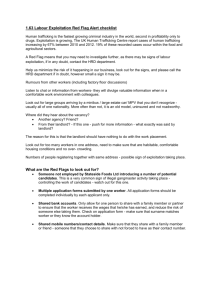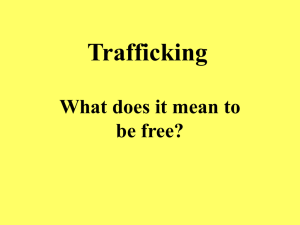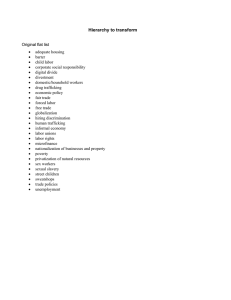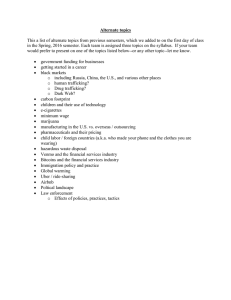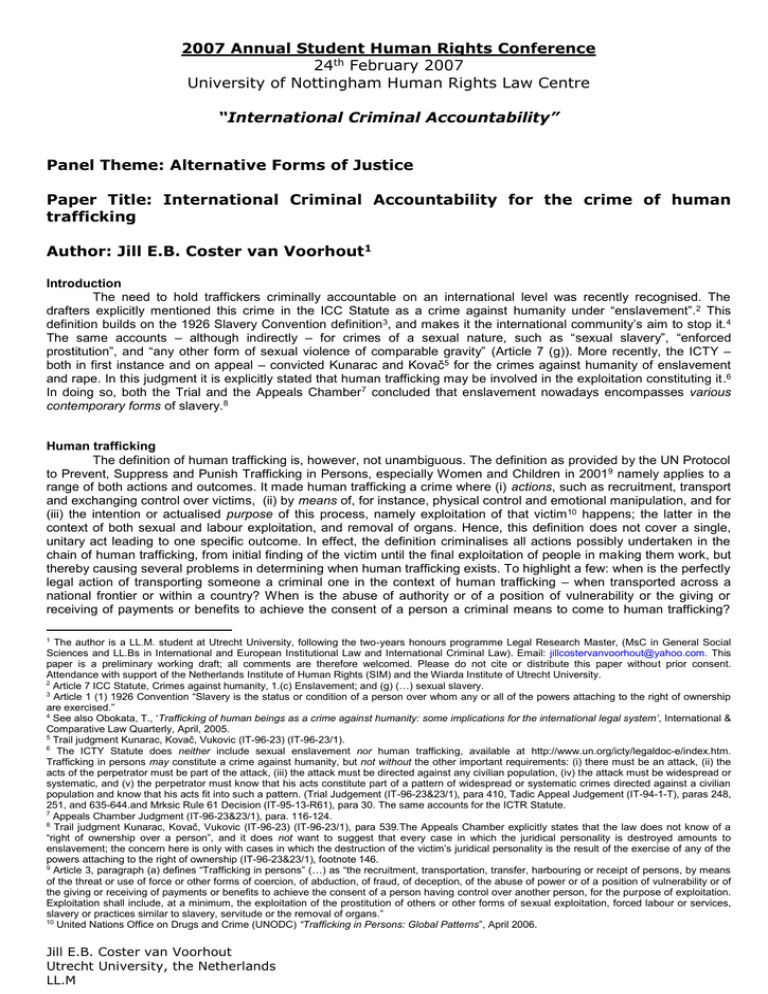
2007 Annual Student Human Rights Conference
24th February 2007
University of Nottingham Human Rights Law Centre
“International Criminal Accountability”
Panel Theme: Alternative Forms of Justice
Paper Title: International Criminal Accountability for the crime of human
trafficking
Author: Jill E.B. Coster van Voorhout1
Introduction
The need to hold traffickers criminally accountable on an international level was recently recognised. The
drafters explicitly mentioned this crime in the ICC Statute as a crime against humanity under “enslavement”.2 This
definition builds on the 1926 Slavery Convention definition 3, and makes it the international community’s aim to stop it. 4
The same accounts – although indirectly – for crimes of a sexual nature, such as “sexual slavery”, “enforced
prostitution”, and “any other form of sexual violence of comparable gravity” (Article 7 (g)). More recently, the ICTY –
both in first instance and on appeal – convicted Kunarac and Kovač5 for the crimes against humanity of enslavement
and rape. In this judgment it is explicitly stated that human trafficking may be involved in the exploitation constituting it.6
In doing so, both the Trial and the Appeals Chamber 7 concluded that enslavement nowadays encompasses various
contemporary forms of slavery.8
Human trafficking
The definition of human trafficking is, however, not unambiguous. The definition as provided by the UN Protocol
to Prevent, Suppress and Punish Trafficking in Persons, especially Women and Children in 20019 namely applies to a
range of both actions and outcomes. It made human trafficking a crime where (i) actions, such as recruitment, transport
and exchanging control over victims, (ii) by means of, for instance, physical control and emotional manipulation, and for
(iii) the intention or actualised purpose of this process, namely exploitation of that victim 10 happens; the latter in the
context of both sexual and labour exploitation, and removal of organs. Hence, this definition does not cover a single,
unitary act leading to one specific outcome. In effect, the definition criminalises all actions possibly undertaken in the
chain of human trafficking, from initial finding of the victim until the final exploitation of people in making them work, but
thereby causing several problems in determining when human trafficking exists. To highlight a few: when is the perfectly
legal action of transporting someone a criminal one in the context of human trafficking – when transported across a
national frontier or within a country? When is the abuse of authority or of a position of vulnerability or the giving or
receiving of payments or benefits to achieve the consent of a person a criminal means to come to human trafficking?
1
The author is a LL.M. student at Utrecht University, following the two-years honours programme Legal Research Master, (MsC in General Social
Sciences and LL.Bs in International and European Institutional Law and International Criminal Law). Email: jillcostervanvoorhout@yahoo.com. This
paper is a preliminary working draft; all comments are therefore welcomed. Please do not cite or distribute this paper without prior consent.
Attendance with support of the Netherlands Institute of Human Rights (SIM) and the Wiarda Institute of Utrecht University.
2
Article 7 ICC Statute, Crimes against humanity, 1.(c) Enslavement; and (g) (…) sexual slavery.
3
Article 1 (1) 1926 Convention “Slavery is the status or condition of a person over whom any or all of the powers attaching to the right of ownership
are exercised.”
4
See also Obokata, T., ‘Trafficking of human beings as a crime against humanity: some implications for the international legal system’, International &
Comparative Law Quarterly, April, 2005.
5
Trail judgment Kunarac, Kovač, Vukovic (IT-96-23) (IT-96-23/1).
6
The ICTY Statute does neither include sexual enslavement nor human trafficking, available at http://www.un.org/icty/legaldoc-e/index.htm.
Trafficking in persons may constitute a crime against humanity, but not without the other important requirements: (i) there must be an attack, (ii) the
acts of the perpetrator must be part of the attack, (iii) the attack must be directed against any civilian population, (iv) the attack must be widespread or
systematic, and (v) the perpetrator must know that his acts constitute part of a pattern of widespread or systematic crimes directed against a civilian
population and know that his acts fit into such a pattern. (Trial Judgement (IT-96-23&23/1), para 410, Tadic Appeal Judgement (IT-94-1-T), paras 248,
251, and 635-644.and Mrksic Rule 61 Decision (IT-95-13-R61), para 30. The same accounts for the ICTR Statute.
7
Appeals Chamber Judgment (IT-96-23&23/1), para. 116-124.
8
Trail judgment Kunarac, Kovač, Vukovic (IT-96-23) (IT-96-23/1), para 539.The Appeals Chamber explicitly states that the law does not know of a
“right of ownership over a person”, and it does not want to suggest that every case in which the juridical personality is destroyed amounts to
enslavement; the concern here is only with cases in which the destruction of the victim’s juridical personality is the result of the exercise of any of the
powers attaching to the right of ownership (IT-96-23&23/1), footnote 146.
9
Article 3, paragraph (a) defines “Trafficking in persons” (…) as “the recruitment, transportation, transfer, harbouring or receipt of persons, by means
of the threat or use of force or other forms of coercion, of abduction, of fraud, of deception, of the abuse of power or of a position of vulnerability or of
the giving or receiving of payments or benefits to achieve the consent of a person having control over another person, for the purpose of exploitation.
Exploitation shall include, at a minimum, the exploitation of the prostitution of others or other forms of sexual exploitation, forced labour or services,
slavery or practices similar to slavery, servitude or the removal of organs.”
10
United Nations Office on Drugs and Crime (UNODC) “Trafficking in Persons: Global Patterns”, April 2006.
Jill E.B. Coster van Voorhout
Utrecht University, the Netherlands
LL.M
What specifically constitutes exploitation in the context of human trafficking – whether in the context of sex work11 or
other labour?
Suggested complementary interpretational model for human trafficking
To solve the above-mentioned questions, it is suggested to define human trafficking with a temporal division, wherein
two stages are recognised: (a) transportation and/or recruitment phase and (b) the exploitation phase, as follows:
Prospectively
(i.a)
a person is smuggled or trafficked across an
international frontier with the intention of subsequent
exploitation (this is thus the only situation that may
overlap with smuggling, and thus the only situation
that may be covered as an illegal immigration issue)
or
(i.b)
a person is trafficked within the country with
the intention of subsequent exploitation;
Currently and/or retrospectively
(ii.a)
a person was smuggled or trafficked
into the country and is now being exploited –
after smuggling in debt bondage for the
“smuggling expenses” or after trafficking
across frontiers, or
(ii.b)
when the person is currently in a
situation of exploitation, possibly but not
necessarily, after being trafficked within the
country.
Secondly, a functional division between the trading aspect and the exploitation aspect is required. Hence, it
adds up to four crucial elements: the illicit (i) trade in persons within and between countries, in order to (ii) exploit (iii)
that person’s labour that the perpetrator has appropriated, who thereby mostly comes to (iv) subsequent gain.
Lastly, where human trafficking ends up in exploitation, this exploitation must be seen defined as, at a minimum,
a situation of forced labour imposed by a non-State actor, thus conducted under the menace of a penalty (wide
definition) and undertaken involuntarily. It may constitute servitude, where in addition to the obligation to provide certain
services to another (...) the obligation on the “serf” to live on the other’s property and the impossibility of changing his
status” occurs. Human trafficking may also constitute present-day slavery under the current regime of human rights law
where all the above exists and the trafficker exercises any or all of the powers attaching to the right of “ownership” over
a person by getting a – monetary – compensation for the person. The ICTY Appeals Chamber’s guidance in Kunarac
and Kovač can then be followed:
(i)
It must be realised that the mere ability to buy, sell, trade or inherit a person or his or her labours or
services could be a relevant factor, but is not sufficient; such actions actually occurring could be a
relevant factor12;
(ii)
lack of consent is an element of the crime since enslavement flows from claimed rights of ownership
and therefore does not have to be proved13;
(iii)
enslavement is defined by the relationship between the accused and the victim, duration is only one
aspect thereof and is therefore not determining for enslavement14; and
(iv)
mens rea consists of the intentional exercise of a power attaching to the
right of ownership,15 it is not required to prove that the accused intended to detain the victims under
constant control for a prolonged period of time in order to use them, here for sexual acts. 16
Conclusion
To conclude, where the other requirements of crimes against humanity are also found, namely (i) there must be an
attack, (ii) the acts of the perpetrator must be part of the attack, (iii) the attack must be directed against any civilian
population, (iv) the attack must be widespread or systematic, and (v) the perpetrator must know that his acts constitute
part of a pattern of widespread or systematic crimes directed against a civilian population and know that his acts fit into
such a pattern, human traffickers can be held criminally accountable for their actions as contemporary forms of slavery,
namely for the trading aspect under other inhumane acts (7 (1) (k) ICC Statute) and for the subsequent exploitation
under enslavement (7 (1) (c) ICC Statute) and/or sexual slavery as a type of enslavement, although separately listed
under 7 (1) (g) ICC Statute, in compliance with the elements of crime. The same possibly accounts for the relevant war
crimes, such as Article 8 2 (a) (vii) unlawful transfer and 8 2 (b) (xxi) outrages upon human dignity and 8 2 (b) (xxii)
sexual slavery – also with reference to forced labour in the elements of crime – when committed as part of a plan or
policy or as part of a large-scale commission of such crimes.
E.g. Human Rights Watch, ‘The Human Rights Watch global report on women’s human rights, Womens’ Rights Project’, New York: Human Rights
Watch, 1995, and Kelly, L. and Regan, L., ‘ Stopping traffic: exploring the extent of, and responses to, trafficking in women for sexual exploitation in
the UK’, London: Home Office, Policing and Reducing Crime Unit, 2000.
12
Appeals Chamber Judgment (IT-96-23&23/1), para. 119.
13
Appeals Chamber Judgment (IT-96-23&23/1), para. 120.
14
Trial Judgment (IT-96-23&23/1), para 542.
15
Trial Judgment (IT-96-23&23/1), para 540. Appeals Chamber Judgment, para. 121.
16
Appeals Chamber Judgment (IT-96-23&23/1), para. 122.
11
Jill E.B. Coster van Voorhout
Utrecht University, the Netherlands
LL.M



